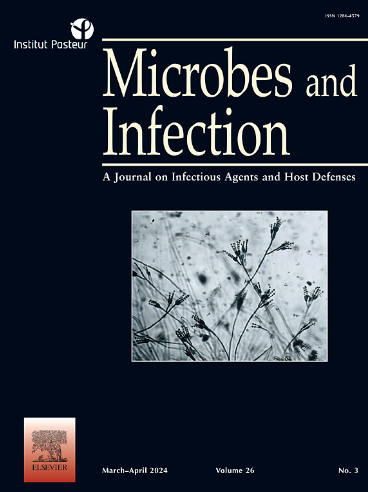The dual M protein systems have diverse biological characteristics, but both contribute to M18-type Group A Streptococcus pathogenicity
IF 2.7
4区 医学
Q3 IMMUNOLOGY
引用次数: 0
Abstract
M protein is a key surface virulence factor in Group A Streptococcus (GAS), Group C Streptococcus (GCS), and other streptococcal species. GAS encodes M protein using the emm gene, while GCS employs the szm (or sem) gene. In M18-type GAS, dual M protein systems exist, comprising both GAS and GCS M proteins (encoded separately by emm18 and spa18). The spa18 gene in M18-type GAS shares a conserved region highly similar to GCS's szm gene. Our study reveals that spa18 exhibits higher transcription levels than emm18 in M18-type GAS strains. The dual M protein systems defective mutant (Δemm18Δspa18) displays a smooth surface, whereas wild-type and single M protein gene mutants remain rough. M18 and SPA18 proteins possess distinct characteristics, showing varied binding properties and cytotoxicity effects on macrophages (THP-1) and keratinocytes (HaCaT). Both emm18 and spa18 genes contribute to the skin pathogenicity of M18-type GAS. Transcriptome analysis suggests the potential involvement of the mga gene in spa18 transcription regulation, while SpyM18_2047 appears to be specific to spa18 regulation. In summary, this research offers a crucial understanding of the biological characteristics of dual M protein systems in M18-type GAS, highlighting their contributions to virulence and transcriptional regulation.
双M蛋白系统具有不同的生物学特性,但两者都有助于M18型A组链球菌的致病性。
M蛋白是a组链球菌(GAS)、C组链球菌(GCS)和其他链球菌物种的关键表面毒力因子。GAS使用emm基因编码M蛋白,而GCS使用szm(或sem)基因。在M18型GAS中,存在双M蛋白系统,包括GAS和GCS M蛋白(分别由emm18和spa18编码)。M18型GAS中的spa18基因与GCS的szm基因具有高度相似的保守区。我们的研究表明,在M18型GAS菌株中,spa18表现出比emm18更高的转录水平。双M蛋白系统缺陷突变体(Δemm18Δspa18)显示出光滑的表面,而野生型和单M蛋白基因突变体保持粗糙。M18和SPA18蛋白具有不同的特性,对巨噬细胞(THP-1)和角质形成细胞(HaCaT)表现出不同的结合特性和细胞毒性作用。emm18和spa18基因都参与了M18型GAS的皮肤致病性。转录组分析表明mga基因可能参与spa18转录调控,而SpyM18_2047似乎对spa18调控具有特异性。总之,这项研究对M18型GAS中双M蛋白系统的生物学特性有了至关重要的了解,突出了它们对毒力和转录调控的贡献。
本文章由计算机程序翻译,如有差异,请以英文原文为准。
求助全文
约1分钟内获得全文
求助全文
来源期刊

Microbes and Infection
医学-病毒学
CiteScore
12.60
自引率
1.70%
发文量
90
审稿时长
40 days
期刊介绍:
Microbes and Infection publishes 10 peer-reviewed issues per year in all fields of infection and immunity, covering the different levels of host-microbe interactions, and in particular:
the molecular biology and cell biology of the crosstalk between hosts (human and model organisms) and microbes (viruses, bacteria, parasites and fungi), including molecular virulence and evasion mechanisms.
the immune response to infection, including pathogenesis and host susceptibility.
emerging human infectious diseases.
systems immunology.
molecular epidemiology/genetics of host pathogen interactions.
microbiota and host "interactions".
vaccine development, including novel strategies and adjuvants.
Clinical studies, accounts of clinical trials and biomarker studies in infectious diseases are within the scope of the journal.
Microbes and Infection publishes articles on human pathogens or pathogens of model systems. However, articles on other microbes can be published if they contribute to our understanding of basic mechanisms of host-pathogen interactions. Purely descriptive and preliminary studies are discouraged.
 求助内容:
求助内容: 应助结果提醒方式:
应助结果提醒方式:


